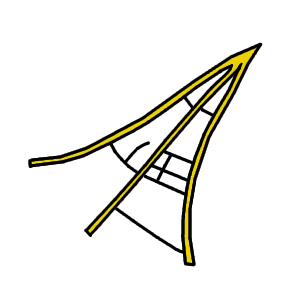Thorns, spines, and prickles






Thorns, spines, and prickles are all types of sharp structures found on plants that serve primarily as a defense mechanism against herbivores. Despite their similar function and appearance, they originate from different parts of the plant, making them distinct in terms of their botanical definition and development. Understanding these structures not only provides insight into plant evolution and adaptation but also aids in the identification and study of various plant species.
Thorns[edit]
Thorns are modified branches or stems that are hard and pointed. They are deeply embedded in the plant's structure and cannot be easily broken off. Thorns are found in a variety of plants, including certain species of Citrus and Rosa. They serve to deter animals from eating the plant material by causing physical injury or discomfort.
Spines[edit]
Spines are modified leaves, stipules, or parts of leaves, such as the extension of a leaf vein. Cacti, notably members of the Cactaceae family, are well-known for their spines. These structures can vary greatly in size, shape, and number, and they play a crucial role in water conservation by reducing air flow close to the cactus surface and thereby reducing water loss through transpiration. Additionally, spines provide shade to the plant surface, further aiding in the reduction of water loss.
Prickles[edit]
Prickles are sharp outgrowths of the plant's epidermis or bark and can be easily broken off from the plant. Unlike thorns and spines, prickles are not derived from deep plant tissues. Roses are a common example of plants with prickles. These structures are often found along the stems and can vary in size and sharpness.
Adaptations and Functions[edit]
The primary function of thorns, spines, and prickles is to protect the plant from herbivores and sometimes from humans. By presenting a physical barrier, these structures can significantly reduce the damage caused by animals attempting to eat the plant. In some cases, they also serve additional functions such as reducing water loss, providing shade, and even aiding in climbing for certain vine species by anchoring the plant to supporting structures.
Evolutionary Significance[edit]
The evolution of thorns, spines, and prickles is a fascinating example of how plants adapt to their environment. These structures have independently evolved in various plant lineages as a response to herbivory pressure. This convergent evolution demonstrates the similar strategies plants employ to survive and reproduce in environments where they are under constant threat from herbivores.
Conclusion[edit]
Thorns, spines, and prickles are critical components of plant defense and survival strategies. Their presence on plants serves as a physical deterrent to herbivores and plays a significant role in the plant's ability to thrive in its natural habitat. By understanding the differences and functions of these structures, one can appreciate the complexity and diversity of plant adaptations.

Ad. Transform your life with W8MD's Budget GLP-1 injections from $75


W8MD offers a medical weight loss program to lose weight in Philadelphia. Our physician-supervised medical weight loss provides:
- Weight loss injections in NYC (generic and brand names):
- Zepbound / Mounjaro, Wegovy / Ozempic, Saxenda
- Most insurances accepted or discounted self-pay rates. We will obtain insurance prior authorizations if needed.
- Generic GLP1 weight loss injections from $75 for the starting dose.
- Also offer prescription weight loss medications including Phentermine, Qsymia, Diethylpropion, Contrave etc.
NYC weight loss doctor appointmentsNYC weight loss doctor appointments
Start your NYC weight loss journey today at our NYC medical weight loss and Philadelphia medical weight loss clinics.
- Call 718-946-5500 to lose weight in NYC or for medical weight loss in Philadelphia 215-676-2334.
- Tags:NYC medical weight loss, Philadelphia lose weight Zepbound NYC, Budget GLP1 weight loss injections, Wegovy Philadelphia, Wegovy NYC, Philadelphia medical weight loss, Brookly weight loss and Wegovy NYC
|
WikiMD's Wellness Encyclopedia |
| Let Food Be Thy Medicine Medicine Thy Food - Hippocrates |
Medical Disclaimer: WikiMD is not a substitute for professional medical advice. The information on WikiMD is provided as an information resource only, may be incorrect, outdated or misleading, and is not to be used or relied on for any diagnostic or treatment purposes. Please consult your health care provider before making any healthcare decisions or for guidance about a specific medical condition. WikiMD expressly disclaims responsibility, and shall have no liability, for any damages, loss, injury, or liability whatsoever suffered as a result of your reliance on the information contained in this site. By visiting this site you agree to the foregoing terms and conditions, which may from time to time be changed or supplemented by WikiMD. If you do not agree to the foregoing terms and conditions, you should not enter or use this site. See full disclaimer.
Credits:Most images are courtesy of Wikimedia commons, and templates, categories Wikipedia, licensed under CC BY SA or similar.
Translate this page: - East Asian
中文,
日本,
한국어,
South Asian
हिन्दी,
தமிழ்,
తెలుగు,
Urdu,
ಕನ್ನಡ,
Southeast Asian
Indonesian,
Vietnamese,
Thai,
မြန်မာဘာသာ,
বাংলা
European
español,
Deutsch,
français,
Greek,
português do Brasil,
polski,
română,
русский,
Nederlands,
norsk,
svenska,
suomi,
Italian
Middle Eastern & African
عربى,
Turkish,
Persian,
Hebrew,
Afrikaans,
isiZulu,
Kiswahili,
Other
Bulgarian,
Hungarian,
Czech,
Swedish,
മലയാളം,
मराठी,
ਪੰਜਾਬੀ,
ગુજરાતી,
Portuguese,
Ukrainian